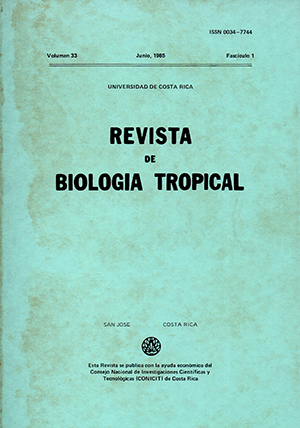Resumen
Se compararon diferentes aspectos de las asociaciones satelíticas, presentes en dos grupos de 200 células cada uno (2 por individuo), correspondientes a 100 madres post-parto, con edades comprendidas entre 14 y 43 años y 100 neonatos (51 hombres y 49 mujeres), provenientes de la población de Puriscal, Costa Rica.
Varios tipos de asociaciones satelíticas mostraron una proporción significativamente mayor en las madres. Las asociaciones más frecuentes en los dos grupos fueron las de dos cromosomas, seguidas en frecuencia por las de tres cromosomas.
La relación D/G fue de 1,43 en los niños y de 1,40 en las madres; el número de asociaciones por célula fue casi el doble en las madres; el número medio de acrocéntricos por asociación fue de 2,2 en los niños y de 2,3 5 en las madres.
No se reveló diferencias significativas entre los valores observados y esperados de cromosomas D y G involucra dos en asociaciones en ambos grupos, de manera que los factores no determinados aún, implicados en el aumento de asociaciones satelíticas en las madres, influenciaron de manera similar a los dos tipos de cromosomas acrocéntricos.
Citas
Bishun, N., J. Milis, N. LLoyd, D.C. Williams, & E. Gristwood. 1972. Chromosomal satellite association in women using oral contraceptives and their progeny. Cytologia, 37: 639-642.
Cohen, M.M., & M.W. Shaw. 1967. The association of acrocentric chromosomes in 1000 normal male metaphase cell s. Ann. Hum. Genet., 31: 129-139.
Cooke, P. 1972. Age-related variation in the number of secondary associations between acrocentric chromosomes in normal females and patients with Turner's syndrome. Humangenetik, 17: 29-35.
DiLernia, R., M.L. Riva, L. Dalora, & E. Ginelli. 1980. Satellite associations and silver staining in a case of multiple G and D variants. Hum. Genet, 53: 237-240.
Dittes, H., W. Krone, K. Bross, M. Schmid, & W. Yogel. 1975. Biochemical and genetic studies on the nucleolus organizing regions (NOR) of man. 11. A family with the 15/21 translocation. Humangenetik, 26: 47-59.
Ferguson-Smith, A.A., & S.D. Handmaker. 1961. Observations on the satellited human chromosomes. Lancet, 1: 638-640.
Galperin-Lemaitre, H., L. Hens, & B. Sele. 1980. Comparison of acrocentric associations in male and female cells. Relationship to the active nucleolar organizers. Hum. Genet., 54: 349-353.
Hansson, A. 1970 a. Differences in the satellite association pattern in the human population. Hereditas, 66: 21-30.
Hansson, A. 1970 b. The influence of culture method on the satellite association pattern in human lymphocytes: macroculture versus microculture. Hereditas, 66: 31-34.
Hansson, A. 1979 a. Associations between human acrocentric chromosomes. Resumen de tesis. Universidad de Lund, Lund, Suecia. 17 p.
Hansson, A. 1979 b. Satellite association in human me taphases. A comparative study of normal individuals, patients with Down's syndrome; and their parents. Hereditas, 90: 59-83.
Harnden, D.G. 1961. The chromosomes, p. 19-3 8. In Recent advances in human genetics. Little Brown, Boston.
Hens, L., M. Kirsch-Yolders, F.E. Arrighi, & C. Susanne. 1980. Relationship between measured chromosome distribution parameters and Ag-staining of the nucleolus organizer regions. Hum. Genet., 53: 363-370.
Kumagai, M. 1982. Influence of ageing on satellite association in human chromosomes. Acta Schol. Med. Univ. Gifu, 30: 494-510.
Liem, S.L., T.E. Denton, & K.M. Cheng. 1977. Distribution patterns of satellite association in human lymphocytes relative to age and sex. Clin. Genet., 12: 104-110.
Mattei, J.F., S. Ayme, & M.G. Mattei. 1976. Quantitative and qualitative study of acrocentric associations in 109 normal subjects. Hum. Genet., 34: 185-194.
Mattei, M.G., N. Souiah, S. Aymé, J.F. Mattei, & F. Giraud. 1981. Variabilité interindividuelle des associations entre chromosomes acrocentriques. J. Génét. Hum., 29: 181-189.
Morton, C.C., L.A. Corey, W.E. Nance, & J.A. Brown. 1981. Quinacrine mustard and nucleolar organizer region heteromorphism in twins. Acta. Genet. Med. Gemellol., 30: 39-49.
Ohno, S., J.M. Trujillo, W.D. Kaplan, & R. Kinosita. 1961. Nucleolus-organizers in the causation of chromosomal anomalies in man. Lancet, 2: 123-126.
Priest, J.H. 1977. Medical Cytogenetics and Cell Culture. Lea & Febiger, Philadelphia, 2a ed. 344 p.
Sigmund, J., H.G. Schwan acher, & A.V. Mikelsaar. 1979. Satellite association frequency and number of nucleoli depend on cell cycle duration and NOR activity: Studies on rust, second, and third mitoses of lymphocyte cultures. Hum. Genet., 50: 81-91.
Vormittag, W. 1980. Effect of age and cultivation time on acrocentric associations in females. Aktuel. Gerontol., 10: 309-318.
Warburton, D., K.C. Atwood, & A.S. Henderson. 1976. Variation in the number of genes for rRNA among human acrocentric chromosomes: correlation with frequency of satellite association. Cytogenet. Cell. Genet., 17: 221-230.
Yip, M.Y ., & D.P. Fox. 1981. Variation in pattern and frequency of acrocentric association in normal and trisomy-21 individuals. Hum. Genet., 59: 14-22.
Zakharov, A.F., A.Z. Davudov, V.A. Benjush, & N.A. Egolina. 1982. Genetic determination of NOR activity in human lymphocytes from twins. Hum. Genet., 60: 24-29.
Zang, K.D., & E. Back. 1967. Individual satellite association patterns. Lancet, 2: 1423.
Comentarios

Esta obra está bajo una licencia internacional Creative Commons Atribución 4.0.
Derechos de autor 1985 Revista de Biología Tropical


